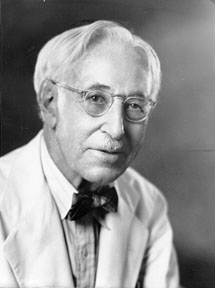Everglades Biographies
Ernest F. Coe
Ernest F. Coe, affectionately known as Tom by his friends, was born in
New Haven, Connecticut, on March 21, 1866. He graduated from Yale
University's School of Fine Arts in 1887. He and his wife Anna came to
Miami in 1925, settling in Coconut Grove. Anna died in 1941.
According to his friend Marjory Stoneman Douglas, writing in her
autobiography Voice of the River, "Coe lost his money in real
estate speculation during the boom and the bust. In the meantime, he'd
discovered the Everglades and decided it should be a national park."
Alarmed at the loss of rare birds through poaching and the removal of rare
or unusual orchids from their natural habitat, Coe feared that many
animals would face extinction if something wasn't done.
In 1928, Coe hatched his plans for a national park to be located within
the lower Everglades. He created the Tropical Everglades National Park
Association and appealed to south Florida notables to join up. Early
members included Miami Herald journalist Marjory Stoneman
Douglas and University of Miami president Dr. Bowman Ashe. Renowned
botanist Dr. David Fairchild served as the association's first president.
As an official of the Tropical Everglades National Park Association,
Coe persisted in gaining local and national support for the park's
establishment. He wrote Stephen T. Mather, director of the National Park
Service, with a draft proposal for the new park. A subsequent meeting took
place. Soon thereafter, Senator Duncan B. Fletcher of Florida introduced
legislation to create Everglades National Park: An Act To authorize
the Secretary of the Interior to investigate and report to Congress on the
advisability and practicability of establishing a national park to be
known as the Tropic Everglades National Park in the State of Florida, and
for other purposes(45 Stat.1443). In spite of considerable
resistance by legislators who failed to see the merits of the proposed
park, and by local landowners who feared lost profits, Coe prevailed.
President Roosevelt signed the enabling act for Everglades National Park
on May 30, 1934. It took another thirteen years to acquire the land and
define the boundaries of the new park.
When Everglades National Park was dedicated in December 1947 the
"father of the Everglades" found little satisfaction in the achievement.
He was gravely disappointed that the final boundaries of the park
comprised a smaller area than originally proposed. Coe had fought, without
success, for inclusion of the upper part of Key Largo, the reef, and part
of the Big Cypress. He insisted that, without these outer areas, the park
wouldn't have the water supply it needed to survive. In the years after
Coe's death, his arguments were found to have merit. Everglades National
Park was expanded with additional acreage; the reef tract gained
protection with the creation of Biscayne National Park and the Florida
Keys National Marine Sanctuary; and Big Cypress was designated as a
national preserve.
Ernest Coe died on January 1, 1951 at age 84. Secretary of the Interior
Oscar Chapman said, "Ernest Coe's many years of effective and unselfish
efforts to save the Everglades earned him a place among the immortals of
the National Park movement." On December 6, 1996, the National Park
Service opened the "Ernest F. Coe Visitor Center" near the entrance of the
park, in honor of "the father of Everglades National Park."
Biography prepared by Gail Clement, Florida
International University

Photo courtesy of History Miami (formerly Historical Museum of Southern Florida).
Excerpts of
essay by Ernest F.
Coe, Tropic Everglades National Park of Florida, October 25, 1928.
Model Land
Company Records, University of Miami.
"The State of Florida and
particularly South Florida is to be congratulated in possessing within its
confines an area so distinctive in its unique physical interests and from
the standpoint of human attractiveness as to type up fully with Uncle
Sam's rigid specifications as a National Park candidate...
From an economic standpoint
it is quite obvious that Florida is very fortunate in possessing this
Cape-Sable area. It places Florida on the map from many substantial
angles. Once the Tropic Everglades National Park of South Florida becomes
a reality such a flow of our great country's people as well as those from
other countries will come into and through the State to visit it that
Florida will profit immeasurably in many ways...
From this angle of approach
it is quite evident that the State of Florida can very well afford to do
its part toward making available such funds and other considerations as is
her share. Individual interests in Florida can be depended upon to
contribute its share and any necessary balance in a required total can
reasonably be expected to be forthcoming from the general public, whose
present appreciation of what our National Parks stand for and a Tropic
National Park especially, produce many individuals so situated that
liberal cash contributions and personal influences will be freely
contributed as not only a duty but a privilege.
Far transcending any economic
consideration as a reason for or means of acquiring this area stands out
the Nation wide importance of preserving this Cape-Sable section of South
Florida as a National Park for all time: -- truly a wonderland supreme and
one of our Nation's choicest jewels."



